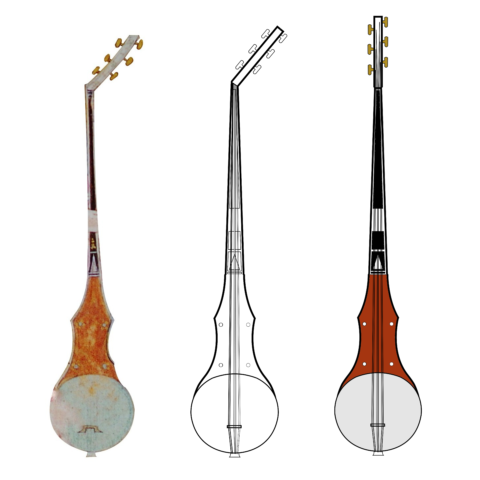
Photography: Detail of the miniature made by Aqa Reza Heravi
Like the Persian rubāb, the qobūz is also made up of a complex cavity: the lower chamber is circular, sometimes even pear-shaped, surmounted by a central chamber similar to that of the Persian rubāb. Only the upper part of the cavity differs on these two instruments. That of the Persian rubāb begins at the base of the neck with the straight plane of the top of the median chamber, for the qobūzthe top of the middle chamber extends into a point, giving shape to the upper chamber.

Montage: Production of the qobūz based on the model proposed by Aqā Rezā
The reconstruction of the Aqā Rezā qobūz was made by reproducing the instrument in the miniature by symmetry. Questions remain: what material is used for the black decoration on the neck? It is not customary to use ebony on this type of instrument. Was the pegbox just inclined or did it have a sickle shape, as is still customary on this type of instrument?

Montage: several views of a Pamir tanbur: front, back and side
The back of the qobūz was not represented by Aqā Rezā, or even by the other miniaturists. In contrast to the Persian rubāb, we have instruments affiliated with the qobūz mughal: the Pamiri tanbur or the Tibetan dranyen. These lutes, of the rubāb type, can be used as a model to make the back of the qobūz.

Image: Reconstruction of the Aqā Rezā qobūz d’Aqā Rezā
The reconstruction of the Aqā Rezā qobūz is based on a vibrating string length of around 74cm, so that the physical intervals between the notes are not too great and remain ergonomic. The strings, of which there are three double strings, would be either silk or gut and tuned to the fourth, as is customary on this type of Central Asian instrument. The body of the instrument is made from mulberry, and the pegs and bridge may also be made from mulberry, or even apricot or walnut. The soundboard could be made of parchment goatskin, 0.2 mm thick.